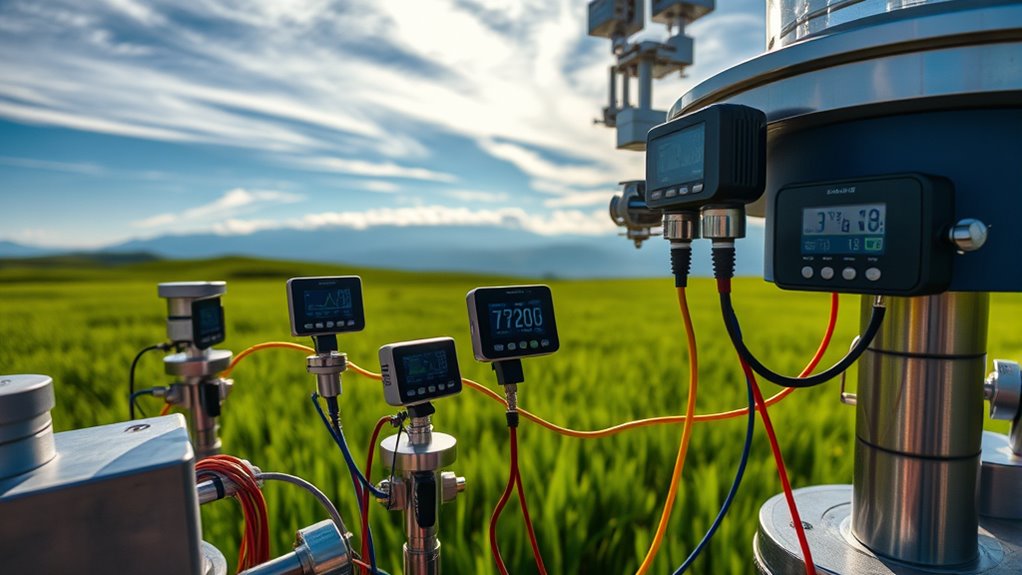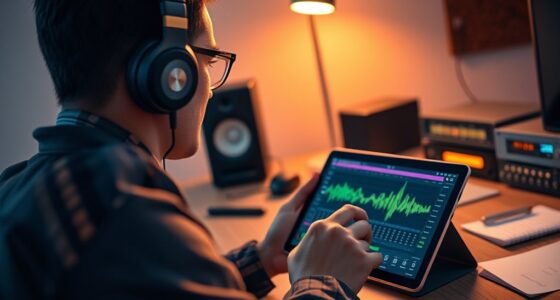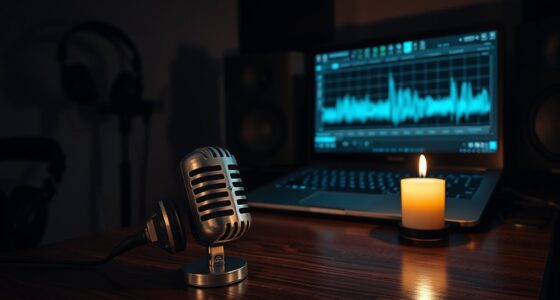To log environmental data step-by-step, start by selecting suitable sensors for your parameters. Calibrate the sensors regularly against known standards to guarantee accuracy. Set up a reliable data logging system to automatically collect and organize your measurements, then document your calibration procedures and data collection methods for transparency. Look for irregularities that may indicate sensor issues and analyze your data for trends and patterns. Keep going to discover more detailed guidance on perfecting your environmental data logging process.
Key Takeaways
- Select appropriate sensors for the environmental parameters you need to monitor.
- Calibrate sensors regularly and document procedures to ensure data accuracy.
- Set up a reliable data logging system with secure storage and timestamping.
- Collect data systematically, organizing it for easy analysis and visualization.
- Analyze the data to identify trends, anomalies, and inform environmental management decisions.

Environmental data logging is a critical process that enables you to monitor and record various environmental parameters, such as temperature, humidity, air quality, and soil conditions. Accurate data collection depends heavily on proper sensor calibration. When you calibrate your sensors correctly, you guarantee that their readings are precise and consistent over time. This involves comparing sensor outputs with known standards or reference measurements and adjusting them accordingly. Regular calibration is essential because sensors can drift or degrade, leading to inaccurate data. Once your sensors are properly calibrated, you can trust the data they collect, which forms the foundation for meaningful data analysis.
Additionally, paying attention to the specific sensor technologies used can significantly improve data reliability and measurement accuracy. Data analysis is the next essential step after setting up your logging system. As you gather environmental data, you need to process and interpret it to uncover trends, patterns, and anomalies. This involves organizing the recorded data into a manageable format, such as spreadsheets or specialized software, making it easier to identify significant changes or issues. You should look for inconsistencies or irregularities that might indicate sensor malfunctions or calibration needs. Analyzing your data also helps you understand environmental conditions over time, which can inform decision-making, policy adjustments, or maintenance schedules. For example, noticing a sudden spike in air pollutants might prompt further investigation or immediate action.
To facilitate effective data analysis, guarantee your data logging system is set up correctly from the start. Choose reliable sensors suited for your specific environment and parameters. Document calibration procedures meticulously, so you can verify when and how sensors were calibrated, and schedule regular calibration checks. Additionally, utilize software tools that offer visualization options like graphs and heat maps, making it easier to interpret complex datasets. These tools can help you quickly spot deviations from normal patterns or identify long-term changes that could impact your environment or operations.
Incorporating sensor calibration and diligent data analysis into your environmental data logging routine enhances the accuracy and usefulness of your data. Proper calibration minimizes errors, while thorough analysis allows you to make informed decisions based on real-world conditions. By following these practices, you guarantee your data logging efforts are effective, reliable, and capable of supporting your environmental management goals. Consistent calibration, organized data collection, and insightful analysis form the backbone of a successful environmental monitoring system that provides valuable, actionable insights.
Frequently Asked Questions
What Are the Best Environmental Data Loggers for Beginners?
For beginners, the best environmental data loggers are user-friendly with clear interfaces and good sensor accuracy. Devices like the HOBO UX100 series or the Elitech RC-5 are ideal because they offer straightforward setup and reliable data collection. These loggers make it easy to monitor temperature, humidity, and other conditions without technical hassle, helping you learn and gather accurate environmental data efficiently.
How Do I Calibrate My Environmental Data Logger?
To calibrate your environmental data logger, start by checking its sensor accuracy against a known standard or calibration source. Follow the calibration procedures outlined in the user manual, which usually involve adjusting settings or recording baseline readings. Regular calibration guarantees your data remains precise over time, helping you identify any sensor drift or errors, so your environmental measurements stay reliable and accurate.
Can Data Loggers Operate in Extreme Weather Conditions?
Like a trusty knight’s armor, your data logger can operate in extreme weather if you employ proper weatherproofing techniques. These devices are designed with extreme temperature resilience, allowing them to withstand harsh conditions. Make certain you select models rated for your environment, add protective enclosures, and seal any openings. With these precautions, your data logger remains reliable, capturing essential data even amid storms or scorching heat, just as a hero faces challenges head-on.
What Are the Data Storage Options for Environmental Data Loggers?
You can store environmental data on cloud storage, which allows remote access and easy sharing, or use removable memory like SD cards or USB drives for local storage. Cloud storage is ideal for real-time data monitoring, while removable memory provides a reliable backup and portability. Choose based on your needs, ensuring your data is secure and accessible, even in remote or extreme environments.
How Secure Is the Data Collected by Environmental Loggers?
Like a knight guarding a treasure chest, your environmental data is quite secure. It’s protected through data encryption, making it difficult for unauthorized folks to access. Plus, access controls ensure only trusted users can view or modify the data. While no system is foolproof, combining encryption and access controls greatly minimizes risks, giving you peace of mind that your collected data remains safe from tampering or breaches.
Conclusion
As you set up your environmental data logger, imagine the quiet hum of sensors capturing the world’s subtle changes—the gentle sway of leaves, the soft drip of rain, the flicker of sunlight through trees. With each recorded data point, you’re creating a vivid snapshot of nature’s story. Embrace this journey, knowing your efforts help protect our planet’s delicate balance. Soon, your logged insights will paint a clearer picture of the environment’s ongoing dance.









